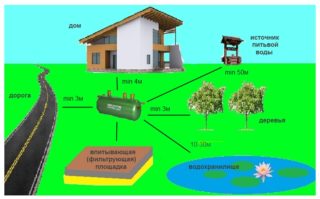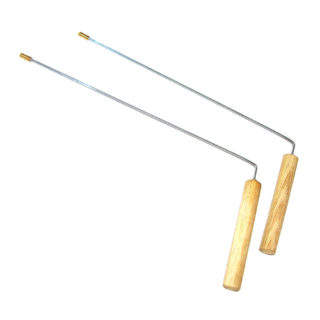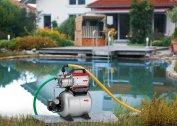The presence of a water well in a personal plot is a vital necessity if central water supply is not provided. Even having a personal car, it is inconvenient to regularly bring water in cans and large containers. You can dig a water well yourself, but you need to arm yourself with knowledge about finding suitable places, the depth of quality water.
Sanitary source location requirements
 The place of water intake should be located away from the toilet, cesspools. Groundwater flow should also be taken into account, the well needs to be drilled at least 50 meters upstream of the overhead stream. If you neglect this rule, it is highly likely that pathogens will enter the water, it will be unsuitable for use.
The place of water intake should be located away from the toilet, cesspools. Groundwater flow should also be taken into account, the well needs to be drilled at least 50 meters upstream of the overhead stream. If you neglect this rule, it is highly likely that pathogens will enter the water, it will be unsuitable for use.
If the area of the personal plot is not more than 4 hundred parts, the minimum distance between the well and the cesspool, toilet should be 8-10 meters.
According to Russian standards, when searching for an aquifer and digging a well, you must avoid:
- the proximity of motorways and public roads (the distance is at least 30 meters);
- regularly flooded areas;
- wetlands.
If clay soil is located on the site, the distance can be slightly reduced.
At what depth to look for good water
 In order to find water on the site for the well yourself, you need to find out at what depth aquifers are located with high-quality water suitable for consumption. Water in the soil does not rise and does not go inland due to the particular composition of the soil of aquifers. The main components are sand and clay. Sand is a natural cleaning filter, and clay is characterized by high moisture resistance.
In order to find water on the site for the well yourself, you need to find out at what depth aquifers are located with high-quality water suitable for consumption. Water in the soil does not rise and does not go inland due to the particular composition of the soil of aquifers. The main components are sand and clay. Sand is a natural cleaning filter, and clay is characterized by high moisture resistance.
The highest concentration of clay sand is collected at the fracture sites of the clay layer. These are the most suitable places for drilling wells, called “underground lakes”.
Choosing a suitable site for the arrangement of the well should also be based on the depth of the aquifer. You can find the source even at a depth of 2-2.5 meters from ground level. But the quality of such water leaves much to be desired, it is unsuitable for drinking, as melt and waste water get into its composition.
To search for quality water, it is better to make a well depth of at least 15 m. As a rule, layers of continental rocks lie at this level. Such a liquid is suitable for drinking, since impressive volumes of sand contribute to its purification.
How to determine a place for a well on a site
To find the location of aquifers, it is not necessary to invite specialists or rent expensive equipment. For centuries, ancestors relied on their experience and observation of animals, plants, and weather.
Insect and animal surveillance
Dogs dig small pits in extreme heat and lie down there. Animals at the level of instincts feel where the coolest places are, therefore, the wettest. This pattern is due to the proximity of the location of aquifers.
With the arrival of the evening, insects huddle in flocks and rush to places with moist soil.
Plant observations
Plants effectively help in finding a suitable place for a well. The proximity of aquifers can be judged by the following signs:
- Thickets of coltsfoot are formed on moist soil, which is constantly fed by groundwater.
- Willow, birch and alder love water and willingly grow only in copiously moistened places.
- Cherries and apple trees, in contrast, do not tolerate excess moisture. Their presence and active growth suggests that no source can be found nearby.If the trees languish and become sick, the likelihood that an aquifer is located nearby is much higher.
Also, plants can determine the depth of the aquifer. Do this as follows:
- In the place where alfalfa grows, the occurrence depth can vary between 1.5-15 meters, but, as a rule, it is limited to 2-3.
- Sandstone reeds live in places where groundwater is at a depth of 1-3 meters.
- At the place of licorice growth, the depth of the water reservoir varies between 1.5-10 meters.
- Wormwood from 3 to 7 meters.
These are the simplest methods that are based solely on observations.
Dowsing method with aluminum frames
Before proceeding with the search for a suitable place, you need to properly make two aluminum frames. The technology is as follows:
- The optimal length of the aluminum rod should be 90 cm and a diameter of at least 3 mm.
- 15 cm are measured from the edges and the rod is bent at a right angle (90 degrees).
- The short ends are inserted into the tubes.
- The diameter of the tube should allow the aluminum rod to rotate freely, but it should not be warped. It is recommended that the diameter of the wire be less than approximately 0.5 mm of the tube.
Frames are taken in both hands. At the same time, it is extremely important to tune in to the search for a suitable place for the well: calm down and fully focus on the “behavior” of the devices. Hands should not be tense and, conversely, relaxed. A man slowly moves around the infield and tests the entire area. Frames become active near places with an aquifer close to the surface.
Desiccant Method
To find a suitable area for drilling, you need to stock up with a moisture-absorbing substance, for example, silica gel, table salt, lime.
In the oven, a large amount of the active component is carefully dried and poured into a clay unvarnished reservoir, wrapping a piece of natural fabric. Prepared work equipment must be weighed on an accurate scale.
In order to avoid mistakes during repeated weighing, it is necessary to record the result on the “device” itself or separately on a sheet. Next, each tank is dug to a depth of about 0.5 m. After a day, they are dug up and re-weighed.
The result of the study is easy to calculate. The more the desiccant mass has increased, the more likely it is that water is present at this point.
The use of glass jars
It is necessary to put dry cans without lids upside down on the territory of the infield. After a few hours, the containers can be inspected.
If there was a strong wetting of the inner surface of the can, then it is highly likely that there is water in this place.



